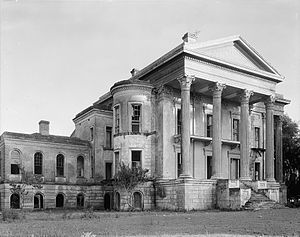Belle Grove Plantation (Iberville Parish, Louisiana)
| Belle Grove | |
|---|---|

Front (River facade) of Belle Grove in 1938
|
|
| Location | White Castle, Louisiana vicinity |
| Coordinates | 30°10′37″N 91°09′14″W / 30.177°N 91.154°WCoordinates: 30°10′37″N 91°09′14″W / 30.177°N 91.154°W |
| Built | 1852–1857 |
| Demolished | 1952 |
| Architectural style(s) | Greek Revival and Italianate |
| Governing body | Private |
Belle Grove, also known as Belle Grove Plantation, was a plantation and elaborate Greek Revival and Italianate-style plantation mansion near White Castle in Iberville Parish, Louisiana. Completed in 1857, it was one of the largest mansions ever built in the South, surpassing that of the neighboring Nottoway. Nottoway is often cited as the largest antebellum plantation house remaining in the South. The masonry structure stood 62 feet (19 m) high and measured 122 feet (37 m) wide by 119 feet (36 m) deep, with seventy-five rooms (including a jail cell) spread over four floors.
Belle Grove was owned by John Andrews, a wealthy sugar planter originally from Virginia. Andrews owned over 7,000 acres (2,800 ha) spread over several plantations, with Belle Grove having 3⁄4 mile (1.2 km) of river frontage. He founded Belle Grove during the 1830s, with Dr. John Phillip Read Stone as a partner. Andrews assumed full ownership in 1844, when the partnership was dissolved. By the 1850s, his more than 150 slaves were producing over one-half million pounds of sugar each year.
Andrews built the mansion from 1852 to 1857 at a cost of $80,000, not including the free (slave) labor or the plentiful cypress lumber and hand-made bricks produced on the plantation. The house was designed by New Orleans architect Henry Howard. Andrews had a legendary rivalry with the owner of Nottoway Plantation, John Randolph. This competition even extended to their mansions, with both massive structures designed by Howard in a mix of the Greek Revival and Italianate styles.
Henry Ware purchased the home from John Andrews after hearing him say he wanted to sell it in New Orleans. Henry Ware and his descendants owned and operated the plantation for 65 years. Two of Henry's sons eventually acquired the estate, James Andrew Ware and John M. Ware. James married Mary Eliza Stone and John married Marie-Louise Dupre', who was related to Jacque Dupre', former governor of Louisiana. Every first-born daughter was named Marie-Louise in straight succession for four generations since. (Marie-Louise Ware Castillo source)
...
Wikipedia
